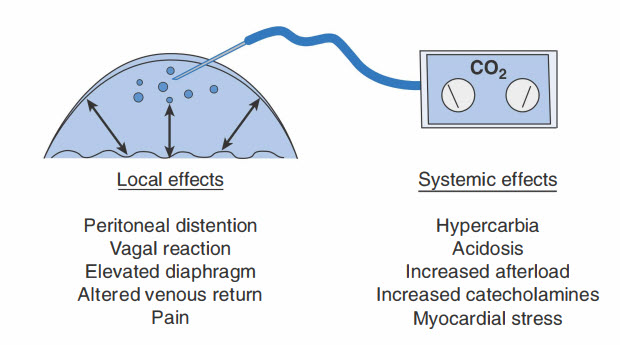Question 4#
Systemic effects of CO2 from pneumoperitoneum can cause all of the following EXCEPT:
A. HypercarbiaB. Increased myocardial oxygen demand
C. Alterations in preload
D. Increased after load
Correct Answer is C
Comment:
Alterations in preload are local effects (pressure specific) of CO2 peritoneum. The physiologic effects of CO2 pneumoperitoneum can be divided into two areas (1) gas-specific effects and (2) pressurespecific effects (Fig. below) . CO2 is rapidly absorbed across the peritoneal membrane into the circulation. In the circulation, CO2 creates a respiratory acidosis by the generation of carbonic acid. Body buffers, the largest reserve of which lies in bone, absorb CO2 (up to 120 L) and minimize the development of hypercarbia or respiratory acidosis during brief endoscopic procedures. Once the body buffers are saturated, respiratory acidosis develops rapidly, and the respiratory system assumes the burden of keeping up with the absorption of CO2 and its release from these buffers. In patients with normal respiratory function, this is not difficult; the anesthesiologist increases the ventilatory rate or vital capacity on the ventilator. If the respiratory rate required exceeds 20 breaths per minute, there may be less efficient gas exchange and increasing hypercarbia. Conversely, if vital capacity is increased substantially, there is a greater opportunity for barotrauma and greater respiratory motion-induced disruption of the upper abdominal operative field. In some situations, it is advisable to evacuate the pneumoperitoneum or reduce the intra-abdominal pressure to allow time for the anesthesiologist to adjust for hypercarbia. Although mild respiratory acidosis probably is an insignificant problem, more severe respiratory acidosis leading to cardiac arrhythmias has been reported. Hypercarbia also causes tachycardia and increased systemic vascular resistance, which elevates blood pressure and increases myocardial oxygen demand.

Carbon dioxide gas insufflated into the peritoneal cavity has both loca l and systemic effects that cause a complex set of hemodynamic and metabolic alterations.